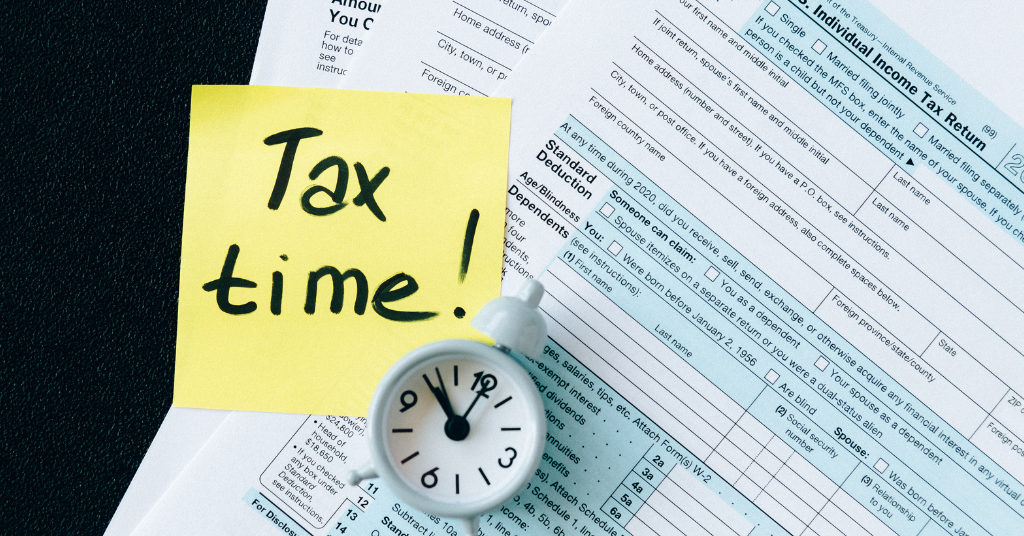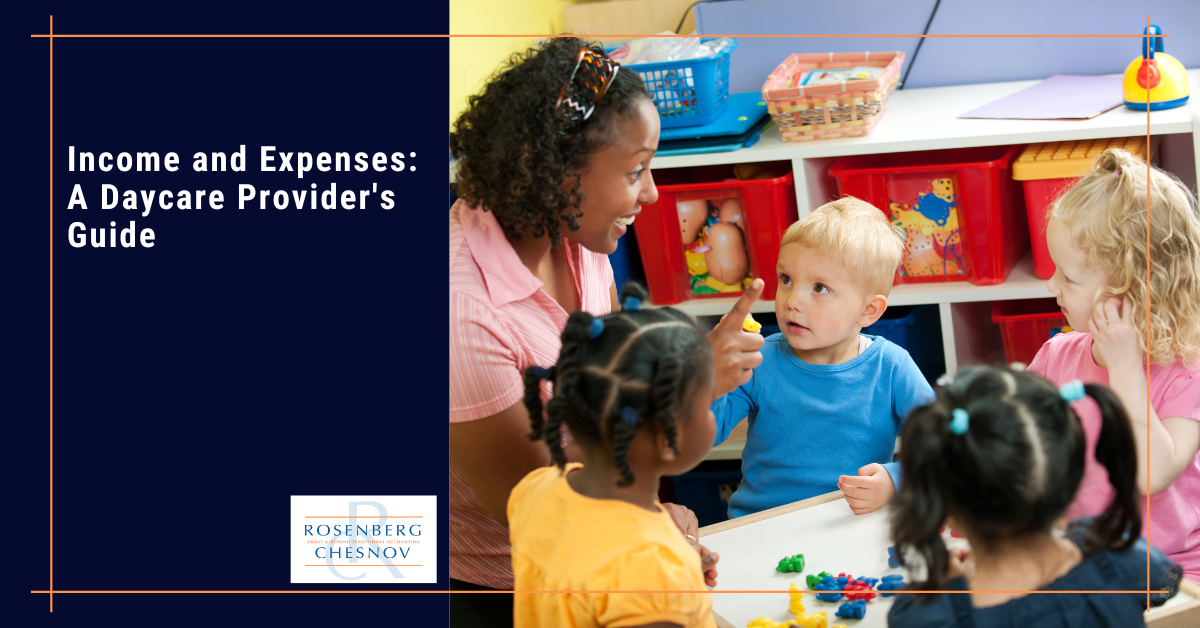

Maximize Your 2024 Refund: Tax Breaks You Might Be Missing
Category: Accounting
59% is approximately how many children that are five or younger who are not enrolled in kindergarten that were in non-parental childcare once a week in 2019. From that group, 62% went to a daycare center, preschool, or prekindergarten center-based care.
As you read this, 7.3% of all children in the United States were in care during the past fifteen to thirty-four hours.
That’s a lot of childcare…which means that for private providers licensed and certified to offer daycare services for compensation, there is plenty of potentially lucrative work.
However, if you are, or are considering becoming, a professional daycare provider, it’s essential that you understand the tax considerations of such an operation. Your income and expenses factor into your obligations at tax time, and filing or record-keeping mistakes can cause headaches down the line. Fortunately, it’s not as scary as it sounds.
To discover more about the tax implications related to income and expenses of operating as a daycare provider, continue reading below.


Let’s start by looking at daycare income: what it is and how to report it.
As a daycare provider, you generally receive income from several sources. For example, you may accept direct payments from parents or guardians or the employee benefit plan of a parent or guardian. Alternatively, subsidy payments from state and local agencies or charitable organizations may go toward specific children in your care. You may also receive income from selling assets used in your daycare business or through grants from the state, local, or private agencies. Finally, expenses you incur may also be reimbursed through programs such as the Child and Adult Care Food Program (CACFP).
Like many forms of income, you need to report your daycare income to the IRS.
Because you are providing daycare services intending to make a profit, the IRS considers any money you make to be self-employment income, which most daycare providers must report along with their expenses on Schedule C (Form 1040). Additionally, if your net income (minus expenses) is $400 or more, you may also need to file Schedule SE (Form 1040) and pay self-employment taxes.
All of the examples of income types cited above are included in your daycare gross income. Furthermore, grants made directly to your business are generally included in business income — if you spend the grant money in your daycare business, you can deduct those expenditures. To do so, most tax professionals recommend you include reimbursements in your gross business income, then claim a deduction.
Even if you operate your daycare business as a sole proprietor or have no employees, obtaining an Employee Identification Number (EIN) is still a good idea. Instead of your Social Security Number, use your EIN on business tax filings like Form W-10, Dependent Care Provider’s Identification, and Certification.
You can also use your EIN for your business bank account, which you use exclusively for depositing daycare income and paying daycare expenses. Having a bank account exclusively for business income and expenses will make your life much easier in terms of record-keeping, as long as you also keep careful track of deposits from your personal funds and reimbursements you make to yourself.
Deposit all your daycare income, including cash payments, into the business bank account, and use a check or debit card associated with that account to pay for business expenses instead of withdrawing cash.
If you do not have a dedicated credit card for business expenses, keep careful track of any daycare expenses you charge to your personal card.
Next, let’s look closer at the expenses side of the equation.
The IRS allows all businesses to deduct expenses that are ordinary and necessary. Below are some examples of childcare expenses that meet this qualification.
First, however, it’s essential to make sure you are maintaining careful record-keeping. Your method should clearly show your daycare income and expenses. Whether you use a hand-written ledger, spreadsheets, or business software, ensure that you keep the following additional records up-to-date as well:
Some examples of expenses the IRS may consider ordinary and necessary for your daycare business (and therefore potentially deductible) include the following. Please note that this list is not all-inclusive.
Regarding daycare food, you don’t necessarily need to keep track of every penny spent for children in your care. Instead, you can use the standard meal and snack rates. Those rates for 2022, by location, follow in the table below.
| 2022 Rates by Location | Breakfast | Lunch, Dinner* | Snacks (up to 3) |
| Continental US | $1.40 | $2.63 | $0.78 |
| Alaska | $2.23 | $4.26 | $1.27 |
| Hawaii | $1.63 | $3.08 | $0.91 |
| *Lunch and dinner, allowance for each |
Part of the cost of maintaining your home may also be deductible as a business expense. However, some qualifications apply. For example, you must have (or be exempt from having) a license or other approval to operate your daycare business under state law.
Suppose you do meet all necessary qualifying conditions. In that case, you can deduct the business portion of some of your home-related expenses, such as real estate taxes and mortgage interest, casualty losses, qualified mortgage insurance premiums (if available), and more. These expenses are deductible whether or not you are in business.
Other expenses are deductible only if deducted for your business. These include homeowner’s insurance and association dues, rent (if renting your home), repairs and maintenance, security systems, utilities and services, and depreciation (subject to certain limitations).
You can calculate your home business-use percentage using the number of hours spent on daycare activities during the year and the area you regularly use for daycare compared to the total square footage of your home.
If you are a client and would like to book a consultation, call us at +1 (212) 382-3939 or contact us here to set up a time.
If you aren’t a client, why not? We can take care of your accounting, bookkeeping, tax, and CFO needs so that you don’t have to worry about any of them. Interested? Contact us here to set up a no-obligation consultation.
Interested in receiving updates in your mailbox? Check out our newsletter, full of information you can use. It comes out once every two weeks, and you can register for it below.


Category: Accounting


Category: Accounting


Category: Accounting
Send us a message and we will contact you as soon as possible.
Jeff Coyle, CPA, Partner of Rosenberg Chesnov, has been with the firm since 2015. He joined the firm after 20 years of business and accounting experience where he learned the value of accurate reporting, using financial information as a basis for good business decisions and the importance of accounting for management.
He is a diligent financial professional, able to manage the details and turn them into relevant business leading information. He has a strong financial background in construction, technology, consulting services and risk management. He also knows what it takes to create organizations having built teams, grown companies and designed processes for financial analysis and reporting.
His business experience includes:
Creating and preparing financial reporting, budgeting and forecasting.
Planning and preparation of GAAP and other basis financial statements.
Providing insight on financial results and providing advice based on those results.
Jeff also has a long history of helping individuals manage their taxes and plan their finances including:
Income tax planning and strategy.
Filing quarterly and annual taxes.
Audit support.
General financial and planning advice.
Prior to joining the firm in 2015, Jeff was in the private sector where he held senior financial and management positions including Controller and Chief Financial Officer. He has experience across industries, including construction, technology and professional services which gives him a deep understanding of business.
Jeff graduated from Montclair State University, he is a CPA and member of the American Institute of Certified Public Accountants, New York State Society of Certified Public Accountants and New Jersey State Society of Public Accountants.
Jody H. Chesnov, CPA, Managing Partner of Rosenberg Chesnov, has been with the firm since 2004. After a career of public accounting and general management, Jody knows the value of good financials. Clarity, decision making, and strategy all start with the facts – Jody has been revealing the facts and turning them into good business results for more than three decades.
He takes a pragmatic approach to accounting, finance and business. His work has supported many companies on their path to growth, including helping them find investors, manage scaling and overcome hurdles. His experience and passion for business reach beyond accounting and he helps businesses focus on what the numbers mean organizationally, operationally and financially.
He has a particular expertise in early-stage growth companies. His strengths lie in cutting through the noise to come up with useful, out of the box, solutions that support clients in building their businesses and realizing their larger visions.
Prior to joining the firm in 2004, Jody was in the private sector where he held senior financial and management positions including General Manager, Chief Financial Officer and Controller. He has experience across industries, which gives him a deep understanding of business.
Jody graduated with a BBA in Accounting from Baruch College, he is a CPA and member of the American Institute of Certified Public Accountants and New York State Society of Certified Public Accountants.
In addition to delivering above and beyond accounting results, Jody is a member of the NYSCPA’s Emerging Tech Entrepreneurial Committee (ETEC), Private Equity and Venture Capital Committee and Family Office Committee.
He is an angel investor through the Westchester Angels, and has served as an advisor for many startup companies and as a mentor through the Founders Institute.